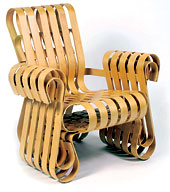
Frank Gehry’s “Power Play” club chair is made of bent wood.
|
Much to the amazement of non-philatelists, stamp collectors aren’t all the same. While one collector thrills to triangle-shaped stamps, another relentlessly hunts stamps from former Communist countries. Still another devoted hobbyist might confine her collecting to stamps featuring airplanes (printed upside-down, if she’s lucky.)
Art lovers usually apply a similarly narrow focus to their collections, limiting their scope by artist, media or time period. Not Joe and Cynthia Kimmel: The Asheville couple assembled their collection of fine art and design, now on display at Western Carolina University’s Fine Art Museum at the Fine and Performing Arts Center, by choosing works that embodied a spirit of discovery. The resultant catalog includes everything from Camille Pissarro’s drawings to a 1954 Coke machine.

Emile Galle’s cameo-cut glass vessel was made around 1930.
|
There are nearly 100 pieces in the show, which museum director Martin DeWitt described in a press release as “eclectic.”
It’s a fair description. But every included piece celebrates constant exploration, a restless search for new knowledge and understanding of the way the world works.
Take the show’s chairs, for example. Each chair represents one artist’s interpretation of the chair as metaphor. One could only perch on Michele De Lucchi’s First Chair, but lounge in great comfort in Le Corbusier’s cowhide chaise. Barbeque Chair, by an unknown designer, leaves its occupant exposed: there are no arms on the chair and the seat and back are made of shaped and painted wire mesh. On the other hand, Henrik Thor-Larsen’s dark-red Ovalia Egg Chair offers womb-like comfort and protection.
The lamps in the exhibition come in previously unimaginable shapes and sizes. An Art Deco sideboard is graced with a pair of lamps with glass pearl-drop shades. The 10-inch drops drift gracefully from their curved top like Ziegfeld showgirls descending a staircase. One lamp is held by a figure of Josephine Baker. The real attention-getter among the lamps is a 4-foot-tall table lamp from 1960: A chrome base holds a basketball-sized white orb with big black polka dots. The tall tapered shade is white with the same black dots.
Photographs include a 1954 portrait of James Dean, a nighttime view of a carnival and a remarkable depiction of Australian children joyfully turning cartwheels in the desert. There is a lovely Matisse aquatint and a somewhat atypical lithograph by Rockwell Kent, dated 1934.
Other two-dimensional works include a lovely Milton Avery drawing of three nudes from 1956 and a 1935 beach scene with lots of loosely painted figures by Maximilien Luce. There are three Andy Warhol prints and a striking Tom Wesselmann serigraph in black, white and two shades of gray. Pissarro’s drawing of a donkey is an outstanding example of why drawing teachers are always yelling “look at it!” Pissarro looked carefully and saw clearly.
Glass and ceramic works are scattered throughout the exhibition. A 22-inch blue-and-white vase by Charles and Ernest Schneider features water plant forms. A 5-inch ceramic bowl from the Van Briggle Pottery is shaped like fluted leaves. A tightly coiled snake forms a Lalique vase: The serpent is open-mouthed and fierce, but the beauty of its scales invites the viewer’s touch.
When it seems you’ve exhausted this cabinet of curiosities, you come across a display of pendants. Sleek and sophisticated, disarmingly simple, they exude elegance in the finest deco tradition. Crafted by Kenneth Cope and Dennis Loss, the conceptual designs are by none other than Joe Kimmel, whose vision as a collector makes the drive to Cullowhee worthwhile.
The Kimmel Collection — Art That Works: A Celebration of Design is at the Fine Arts Museum at Western Carolina University in Cullowhee through Oct. 21. Free. (828) 227-3591.


